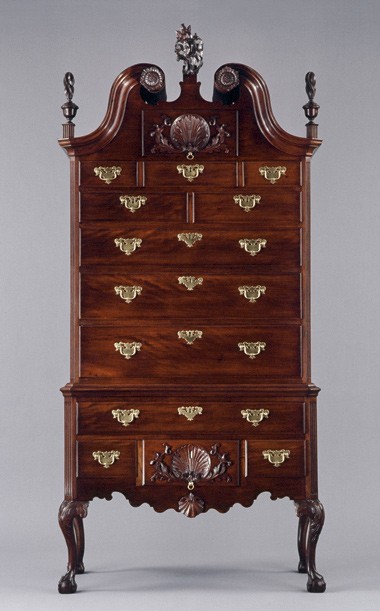
High chest by Henry Cliffton and Thomas Carteret, Philadelphia, Pennsylvania, 1753. Mahogany with tulip poplar, white cedar, and yellow pine. H. 95 1/2", W. 44 1/4", D. 22 1/2". (Courtesy, Colonial Williamsburg Foundation.)

Detail of the case construction of the high chest illustrated in fig. 1. (Photo, Gavin Ashworth.) The upper section of the high chest also has dustboards under the drawers.

Detail of the lower case construction of the high chest illustrated in fig. 1. (Photo, Gavin Ashworth.)

High chest attributed to Henry Cliffton and Thomas Carteret, Philadelphia, Pennsylvania, 1750–1755. Mahogany with tulip poplar, white cedar, and yellow pine. H. 94 1/2", W. 45", D. 23 5/8". (Chipstone Foundation; photo, Gavin Ashworth.)
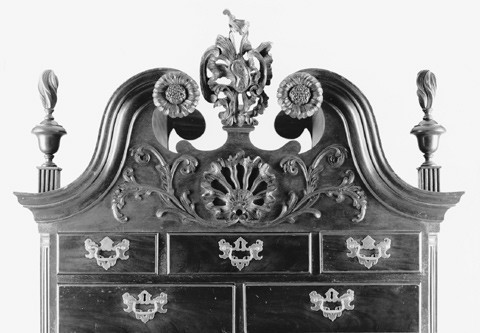
Detail of the pediment of the high chest illustrated in fig. 4. (Photo, Gavin Ashworth.)

Detail of the center cartouche on the high chest illustrated in fig. 4. (Photo, Gavin Ashworth.)

Side chair by James Gillingham, Philadelphia, Pennsylvania, 1768–1773. Mahogany with yellow pine. H. 38 3/4", W. 23 1/2", D. 18 1/2". (Courtesy, White House.)

Benjamin Gasburn, “A Plan of the City of Philadelphia, the Capital of Pennsylvania,” London, 1776. 18 7/8" x 24 3/4". (Courtesy, Winterthur Museum.)
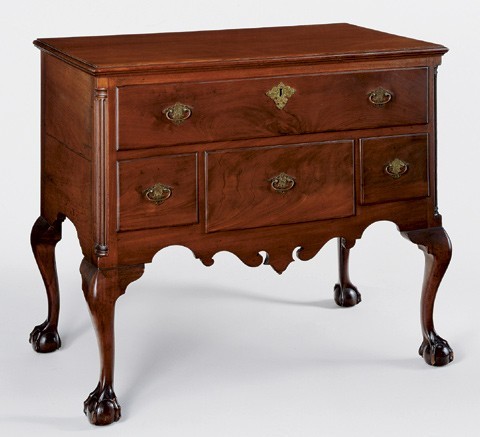
Dressing table attributed to David Evans, Philadelphia, Pennsylvania, 1774. Mahogany with tulip poplar and white pine. H. 30 1/2", W. 35 1/8", D. 20 1/2". (Courtesy, Philadelphia Museum of Art; bequest of Lydia T. Morris.) When she acquired this dressing table in 1774, Beaulah Paschall lived in two homes. The family townhouse, which she probably shared with her brother Joseph, was on Market Street in Philadelphia. Her country house, Cedar Grove, was in Frankford, Pennsylvania. She had inherited it from her mother, Elizabeth Coates Paschall. This dressing table and its mate were intended for one of these homes. The one shown here descended in the Paschall family to Lydia Thompson Morris, who gave it and other ancestral furniture of the Wistar and Morris families to the Philadelphia Museum of Art in 1932.
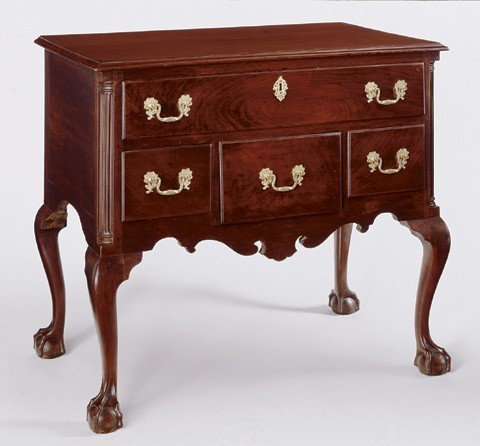
Dressing table attributed to David Evans, Philadelphia, Pennsylvania, 1773–1810. Walnut with tulip poplar and white pine. H. 31 3/4", W. 35 1/2", D. 21 1/2". (Courtesy, Philip H. Bradley Company; photo, Gavin Ashworth.)

Detail of the rear board of the dressing table illustrated in fig. 9. The cabinetmaker used scribe marks to align the nails used to attach the partitions. (Photo, Gavin Ashworth.)
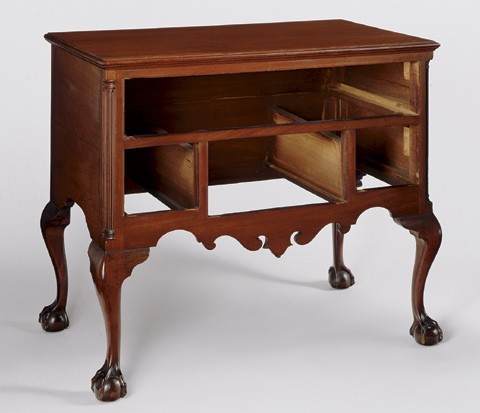
Detail of the interior construction of the dressing table illustrated in fig. 9. (Photo, Gavin Ashworth.)

Entry for December 29, 1781, David Evans Daybooks, Philadelphia, Pennsylvania, 1774–1812. (Courtesy, Historical Society of
Pennsylvania.)
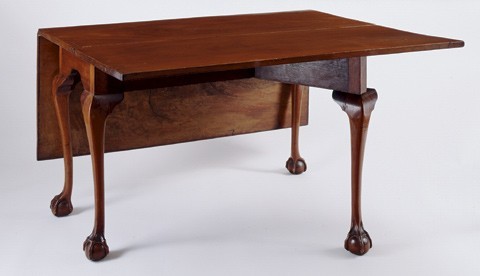
Dining table attributed to David Evans, Philadelphia, Pennsylvania, 1773–1810. Mahogany with oak, tulip poplar, and white pine. H. 28 1/4", W. 48", D. 59 1/2". (Private collection; photo, Gavin Ashworth.) Like the dressing tables illustrated in figs. 9 and 10, the dining table has end rails with flattened stepped arches.
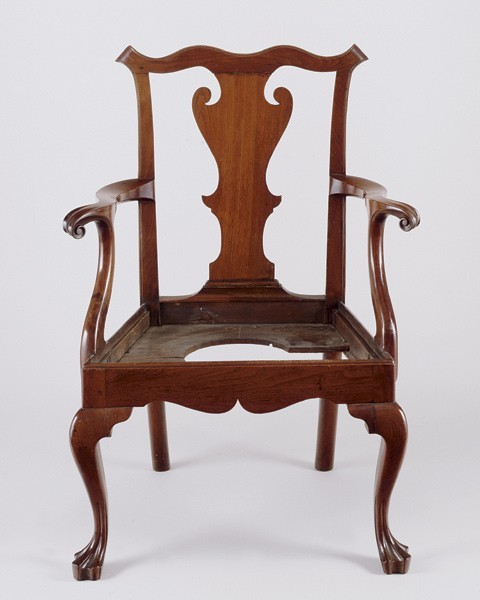
Armchair attributed to David Evans, Philadelphia, Pennsylvania, 1773–1795. Mahogany with white pine. H. 38", W. 23 1/2", D. 18". (Private collection; photo, Gavin Ashworth.) The armchair is stamped “d.evans” on the inside of the rear rail and the underside of the slip seat.

Card table attributed to David Evans, Philadelphia, Pennsylvania, 1788. Mahogany with black walnut and tulip poplar. H. 29 1/2", W. 35 1/2", D. 17". (Courtesy, Philadelphia Museum of Art; photo, Gavin Ashworth.) This card table was one of a pair. The hardware is original.
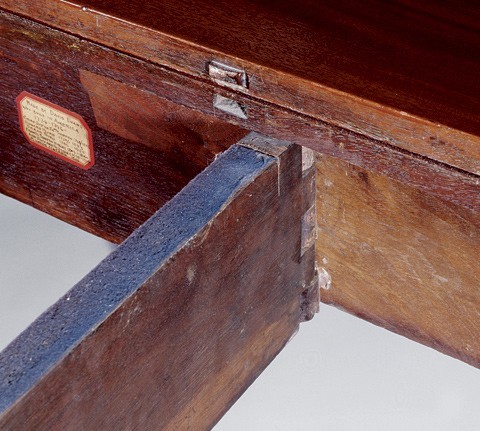
Detail of the flyrail and knuckle joint of the card table illustrated in fig. 16. (Photo, Gavin Ashworth.)
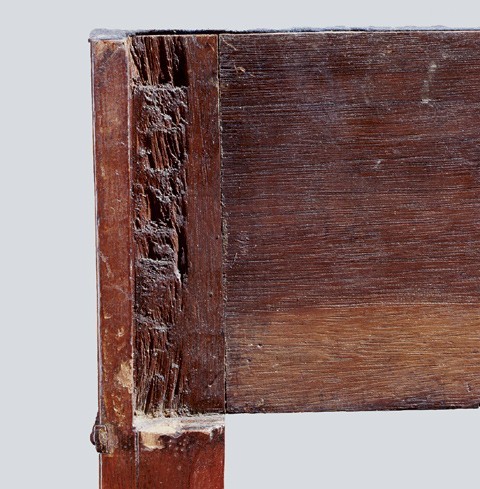
Detail of the flyrail and swing leg of the card table illustrated in fig. 16. (Photo, Gavin Ashworth.)

Tall clock case attributed to David Evans with an eight-day movement by David Rittenhouse, Philadelphia, Pennsylvania, 1789. H. 93", W. 23 1/3", D. 12 3/4". (Courtesy, University of Pennsylvania Art Collection; photo, Gavin Ashworth.)
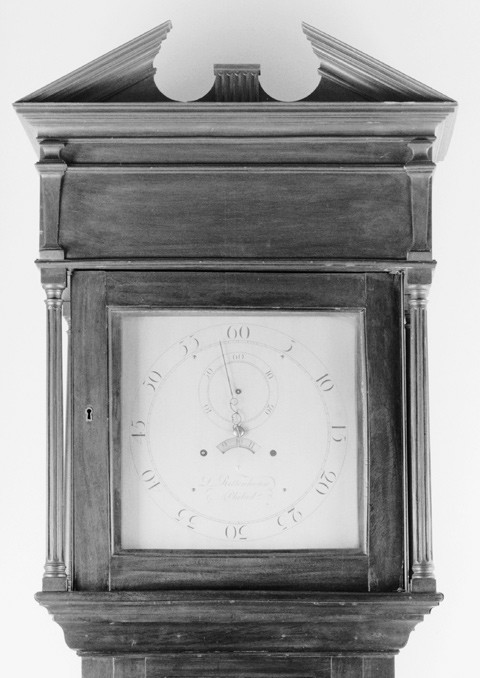
Detail of the hood of the tall clock case illustrated in fig. 19. (Photo, Gavin Ashworth.)
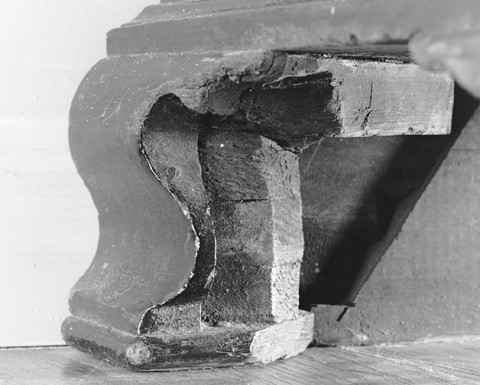
Detail showing the foot construction of the tall clock case illustrated in fig. 19. (Photo, Gavin Ashworth.)
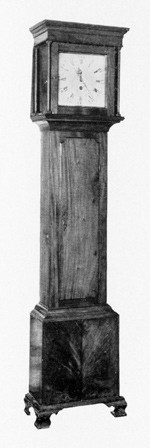
Tall clock case attributed to David Evans with a thirty-hour movement by Benjamin Rittenhouse, Philadelphia, Pennsylvania, 1788. Dimensions and woods not recorded. (William MacPherson Hornor, Blue Book: Philadelphia Furniture [1931; reprint, Alexandria, Va.: Highland House, 1988], pl. 111.) Benjamin Rittenhouse made the movement as a wedding present for Jonathan and Elizabeth (Rittenhouse) Sergeant. Elizabeth was Benjamin’s niece.
In 1786 Philadelphia cabinetmaker David Evans (1748–1819) faced the wrath of merchant Tench Coxe (1755–1824), an irate customer who wrote:
My opinion of the furniture is that it has a great deal of sappy stuff in it, that it is very slight and thin, that the upholsterers work is bad, that it is patched in places much exposed to View, that it was made of unseasoned wood and badly put together. Under these circumstances I think Mr. Evans by no means entitled to the price of well-made furniture.
Coxe made these scathing remarks in a letter to a committee of arbitrators who had been assembled to resolve his four-and-a-half year dispute with Evans. The merchant’s comments about the cabinetmaker’s craftsmanship attacked the quality of his furniture and jeopardized his reputation and career in the process. What caused this private disagreement to escalate into an embarrassing public spat? How had a furniture transaction gotten so out of hand? And, how did the dispute affect the lives of the two men involved? The story behind this furniture is about more than a cabinetmaker’s skills on trial. It is a tale of craftsmanship and ambition colliding with politics and economics in colonial Philadelphia.[1]
The details of Evans’ career, and particularly his business transactions with Coxe, debunk time-honored myths of traditional craftsmanship in eighteenth-century America. Evans was first and foremost a businessman. His success depended on his craft skills and training as well as his commercial savvy and flexibility. During his career, Evans faced not only a typically fickle market, but also political revolution and all of its consequences. As a result, the social, political, and, most importantly, economic context in which he made furniture affected the furniture itself. Physical evidence from surviving pieces attributed to Evans and documentary evidence from his dispute with Coxe prove that even good cabinetmakers made bad furniture.
The Protagonists
David Evans was raised in a successful artisan family as a member of the Society of Friends, or Quakers. While previous scholars postulated that he was born in Gwynedd Township, Pennsylvania, the son of ship joiner and furniture maker Edward Evans, new evidence indicates otherwise. Born in 1748, Evans was the eldest child of Evan and Elizabeth Evans of Philadelphia. His grandfather and namesake, David Evans, owned a shop and tavern on Market Street at the “Sign of the Crown” where he lived with his wife, Elizabeth. The tavern keeper’s will and probate inventory value his estate at £2032.6.42, an impressive amount for a member of the artisan class. The cabinetmaker’s father was a successful cutler who also provided a high standard of living for his family. The administration papers for Evan Evans’ estate list household goods including “Feather Beds, Tables, Chairs, a good eight Day Clock, a large Looking glass, and sundry other...Furniture” as well as “two good Milch Cows, a Chaise horse and Chaise, a considerable Quantity of Dung, Hay and Cord wood, some Rum Hogsheads, and Wine Pipes, with sundry other Things” and three years left on the term of a “likely servant Girl.” His shop inventory included “a Waggon, two Carts, six draught Horses and their Geers, a Mare and Colt, a Sleigh, a Quantity of Cord wood, a Smiths Bellows, new Sickles, some Scale Beams, Iron and sundry Smith Tools, a Plough and Harrow, and sundry other Things.” Evans’ unexpected death in 1758 left Elizabeth with fine household furnishings, a shop full of tools, farm equipment, and livestock, but also an overwhelming amount of debt. She was forced to sell the estate to pay off their debtors, leaving the family without the luxuries to which they had become accustomed. Until that time, her son David had enjoyed a life of relative ease and financial security. The memory of this environment and its loss may have given him the incentive to strive for success and a life more comfortable than that of most artisans.[2]
The Evans family may have received some support from the Society of Friends. Records of the Philadelphia Monthly Meeting indicate that Elizabeth and her children, David, Rebecca, and Sidney, continued to be members after Evan Evans’ death. Yet, on March 14, 1761, Elizabeth married Richard Gardiner who was not a Quaker. Shortly thereafter, the Philadelphia Monthly Meeting disowned her for disregarding the “Discipline Establish’d amongst Us, as to be marry’d by a Priest to a Person not in [our] Religious Fellowship.” David Evans remained a Quaker, suggesting that he may have been an apprentice living outside Elizabeth’s household at the time of her marriage.[3]
At some point during his teenage years, Evans began serving an apprenticeship with two cabinetmakers from his Quaker meeting, Henry Cliffton and James Gillingham. In exchange for Evans’ labor and loyalty, Cliffton and Gillingham taught him the “art and mystery” of cabinetmaking, and provided him with room and board, some schooling, spiritual guidance, and, presumably, the skills to run a business.[4]
Cliffton and Gillingham were both accomplished, enterprising cabinetmakers. A cabriole leg high chest inscribed “Henry Cliffton/ Thomas Carteret/ November 15, 1753” is one of the earliest American examples with nascent rococo ornament (fig. 1). It and its matching dressing table have precisely finished primary and secondary surfaces, finely cut dovetails and mortise-and-tenon joints, and dustboards under the bottom drawers (figs. 2, 3). The dustboards in the dressing table and lower case of the high chest are supported by small strips of wood attached to the sides of the case and partitions separating the drawers. These and other construction details link both pieces to a much more elaborate high chest attributed to Cliffton and Carteret’s shop (fig. 4). The latter example, which also appears to date from the early to mid 1750s, has a large tympanum appliqué (fig. 5), bold flame finials, floral rosettes, and a massive central cartouche (fig. 6). More than any other carving on the chest, the exaggerated leaves and cabachon of the cartouche and tattered shell of the appliqué reflect the influence of British rococo style. The shell, in particular, has an amorphous, abstract quality reminiscent of London work from the late 1740s.
Cliffton’s subsequent partner James Gillingham also kept abreast of prevailing London fashions. The latter’s membership in the Library Company of Philadelphia gave him access to several British design books including Thomas Chippendale’s The Gentleman and Cabinet-Maker’s Director (1754). A Gothic side chair bearing Gillingham’s printed label (fig. 7) is based on a design illustrated on plate 10 of the Director. As their apprentice, David Evans would have been trained to execute precise cabinetwork in the latest styles.
Cliffton and Gillingham dissolved their partnership in August 1768, one year before Evans completed his apprenticeship. Although Evans undoubtedly learned his trade from both partners, evidence suggests that he remained with Cliffton and that their relationship played an important role in the young cabinetmaker’s future career. Cliffton moved his shop to “Arch Street, opposite the gate of [the] Friend’s burying ground” in 1770 and died the following year. Evans, who was twenty-three years old at the time, either inherited his master’s shop and tools, or continued to operate the business for Cliffton’s widow, Rachel. In 1773, Evans rented the land on which this frame cabinet shop stood from Benjamin Loxley. The cabinetmaker signed a five-year lease for the “Lott of Ground in Arch Street opposite the Quaker Burial Ground gate” for £3.15 per year (fig. 8).[5]
The daily transactions of Evans’ shop are recorded in three daybooks, the earliest of which contains furniture entries beginning in 1774. The dressing table illustrated in figure 9 is from his early period. Originally one of a pair, this relatively plain case piece was ordered by merchant Joseph Paschall for his sister Beaulah on July 16, 1774. Evans’ daybook shows that he charged Paschall five pounds per table. A second dressing table has been attributed to Evans based on its similarity to the Paschall example (fig. 10). Both objects have the same basic proportions, fluted quarter columns, thumbnail-molded drawers, side skirts cut from the same template, and similar front skirts. Their claw-and-ball feet are virtually identical, suggesting that the same specialist carved them.
Although some construction details on the tables are similar, others vary. Both case pieces have pinned (pegged) mortise-and-tenon joints, moldings attached with wrought finishing nails, and identical drawer construction. The techniques used to attach the drawer partitions, however, are quite different. The partitions of the dressing table illustrated in figure 9 are nailed to the backboard (figs. 11, 12), whereas those on the other example are glued and tenoned to the backboard. The shallow tenons are the full height of the partitions, and the joints are reinforced with wedges glued into the bottom of each mortise.
Despite these differences, both tables originated in Evans’ shop. His daybooks indicate that at least twelve journeymen and apprentices worked for him in 1774 and 1775 alone. With so many different hands, construction methods must have occasionally varied from piece to piece. The size of Evans’ work force, along with the high volume of orders recorded in his daybooks, indicate that he had a thriving business before the Revolutionary War, and the structure of the two dressing tables attests to the fine quality of his work.
The beginning of the Revolutionary War posed challenges to the young cabinetmaker as orders diminished and labor became scarce. Evans’ business records, however, reveal that he prospered during this tumultuous period. His ability to adapt to changing political and economic circumstances by supplementing his income left him on solid financial ground. Although Evans’ Quaker beliefs prevented him from enlisting, he supported and profited from the war effort by making camp chairs, cot bedsteads, and tent poles, as well as hundreds of staffs and ensign poles for flags and banners. He and his apprentices also received wages from the United States Quartermaster General for packing arms at the gunlock factory. During the British occupation of Philadelphia in the fall of 1777, Evans put his loyalties aside and hauled wood for “His Majesty.” In short, he did whatever it took to survive.[6]
When Evans began his business relationship with Tench Coxe in 1781, he undoubtedly felt confident of his skills as a cabinetmaker, which had been proven before the war, and his ability to thrive in difficult times, which had been tested during the war. Coxe’s experiences also gave him expectations of prosperity and success. He was born in Philadelphia on May 22, 1755, the son of William Coxe, a wealthy merchant, and grandson of Tench Francis, who had served as attorney general of the Province of Pennsylvania from 1741 to 1775. The young Coxe was groomed to continue his family’s legacy of financial power and civic duty. Educated at the Academy College of Pennsylvania, he probably apprenticed with his father’s firm, Coxe and Furman, before becoming a partner in 1776. Two years later, he married Catherine McCall, whose father Samuel was also a prominent merchant.[7]
Catherine died in 1778, and the firm of Coxe, Furman and Coxe disbanded two years later. Tench subsequently established his own mercantile firm and began to court his first cousin, Rebecca Coxe. By the time he commissioned Evans in 1781, his business had begun to rebound from the war. Like many ambitious merchants, Coxe had diversified his investments and supplemented his income by buying and selling land. The latter endeavor brought him together with Evans.[8]
The Contract
In January 1781, Evans paid Coxe £260 for a plot of land on the north side of Arch Street above Sixth Street, just three blocks west of the cabinetmaker’s shop (fig. 8). Measuring twenty feet on Arch Street and one hundred and fourteen feet deep, the plot may have included a kitchen building. Later events suggest that Evans bought the land with the intention of building a new home for his expanding family. When negotiating the contract, Coxe had his family in mind as well. Widowed, but soon-to-be-engaged, Coxe may have foreseen a need for new household goods. He allowed Evans to pay half of the price of the land in furniture. Thus, Coxe extended a one-year cash credit to Evans for £65 and a two-year cash credit for £65. In exchange, Evans credited Coxe with £130 for future furniture orders.[9]
David Evans was not the only artisan with whom Coxe made such an agreement. On July 7, 1781, the merchant sold Philadelphia silversmith Edmond Milne a lot with a three-story brick building and a two-story brick kitchen on the west side of Sixth Street between Arch and Race Streets for £250. Coxe agreed to accept £150 of the total in silver, “the quality & prices to be good & merchantable & the fashion genteel, and to be delivered within four months from this date, at which Time conveyance shall be made valid & in due form of law.” Coxe provided specifications for some of the work in a letter written two days later, adding that he wished “to have well finished plate in the plain stile generally used here.” Coxe even noted that he would send a pattern to Milne for the coffeepot and teapot. It is possible that the merchant was equally involved in the design of his furniture, which may have exacerbated his later disappointment with Evans’ work.[10]
The agreement between Coxe and Milne stipulated that the silversmith deliver £50 in cash at the end of four months and the remaining £50 in cash within the following four months “unless it shall be wanted in plate.” Only when Milne delivered all of the silver could he take possession of the land. Although the contract between Coxe and Evans does not survive, it may have had similar provisions. The deed of transfer between the merchant and the cabinetmaker was not recorded until May 1, 1782, suggesting that Coxe received the furniture prior to conveying the land.[11]
The Transaction
Coxe evidently placed the order for his furniture in November, nine months after entering into the agreement with Evans. On December 29, 1781, the cabinetmaker described the forms required to fulfill his part of the transaction in his daybook (fig. 13). They included ten mahogany Gothic back chairs, two mahogany dining tables, a four-and-a-half foot mahogany sideboard table, a mahogany card table, two lowpost poplar bedsteads, a mahogany knife box, a “plate tray,” a mahogany bedstead with fluted posts, a stained gum headboard and base board, and two pine kitchen tables. Later bills show that Evans also made Coxe a candle box and twelve walnut chairs with Gothic backs at the same time. The merchant required that the cabinetmaker deliver all thirty-four pieces in two months, in time to set up his house for his new bride.[12]
Because of the contract he had signed with Coxe, Evans could not refuse this large and demanding request. Despite the pressure, the cabinetmaker managed to finish the order in the prescribed time. Evans valued his work at £104 and delivered it to Coxe’s home on January 24, 1782.[13]
The Complaint
When Coxe returned from his honeymoon in early March, neither he nor his bride was happy with the furniture Evans had delivered. Undated notes written in Coxe’s hand record that “the dining Table [was] cracked & patched, & thin,” and that the “walnut chairs [were] not peg’d.” He noted that “the mahogy bedstead [was] ricketty, slender & without furniture to this day & without top rails” and “the sideboard table [was] patched in two places.” To validate his complaints, and perhaps to publicly embarrass Evans, Coxe had all the furniture Evans had made for him (including several items made before and after the large order delivered in January) appraised on June 18, 1782, by two of Evans’ fellow cabinetmakers, Francis Trumble and Thomas Affleck. These respected Philadelphia craftsmen determined that “several articles are not merchantable qualities” and that the value of the furniture was less than that charged. Evans valued all of the objects listed in the December entry in his daybook and subsequent bills at £154.17.6, which was more than he owed Coxe in exchange, whereas Trumble and Affleck concluded that the furniture was worth £105.18.[14]
After this evaluation, the intensity of Coxe’s complaints diminished and he commissioned Evans to provide additional furniture for his new home. The cabinetmaker’s sound reputation must have convinced Coxe that the inferior furniture was an anomaly. According to Coxe, Evans still owed the merchant £24.2 worth of furniture on their original contract, and Coxe evidently believed the cabinetmaker would fulfill his obligation in a satisfactory manner. During the next few years, Coxe placed several small orders with Evans. He purchased ten mahogany slat back chairs in May 1782, and in preparation for the birth of his first child in 1783, Coxe commissioned a large pine bureau table, a mahogany easy chair with a feathered cushion, and a mahogany cradle. Clearly wary of the merchant’s anger, Evans wrote Coxe: “I have Strove my best to get a Cradle this morning but Could not If you will be Kind Enough, wait till 5th day I will have as good as a mahogany Cradle made & deliver’d at your House as I can possibly make & Will not Disappoint you by any means, but will work all night.” No record of Coxe’s response is known, but he subsequently complained that the slats of the ten mahogany chairs he ordered in 1782 were “very thin, sappy & the cross pieces among the feet all falling out.” He also admonished Evans for the poor quality of the card tables he received in January 1782 and December 1783 which were “unseasoned and with one handle.”[15]
There is no documentary evidence that Coxe attempted to rectify these problems until 1786, when his financial situation and Philadelphia’s economy had reached “a very disagreeable condition.” Once again, he and Evans disagreed over the value of the furniture that the cabinetmaker had made. Presumably Evans claimed that he had fulfilled, if not exceeded, his contractual obligations, whereas Coxe believed that the cabinetmaker’s work was not worth “the price of well-made furniture.”[16]
Rule of Court
In August 1786, Tench Coxe forced an end to his dispute with Evans. Perhaps sensitive to the Society of Friends aversion to legal proceedings, or possibly desiring to embarrass Evans into settling, Coxe entered a complaint with the Philadelphia Monthly Meeting. The Quakers, who frowned on the practice of maintaining debts, appointed Thomas Morris and William Garrigues to counsel Evans and help him find a solution to his situation. Shortly thereafter, all parties agreed to the appointment of an arbitration committee comprised of the complainant’s and defendant’s peers. The committee, which included “Messers. Bullock, Shields and Claypoole,” had the disputed furniture appraised by Evans’ former journeyman Jesse Williams and by George Claypoole, who may have been one of the arbitrators. Coxe submitted a letter reminding the committee of his complaints, and presumably Evans responded with his defense.[17]
Although the September 12, 1786 “award” was once in the Tench Coxe Papers of the Historical Society of Pennsylvania, the document is now missing. Judging from Evans’ letter to Coxe four months later, the committee found in favor of the merchant, forcing the cabinetmaker to scramble for cash. On January 3, 1787, Evans wrote:
Friend Coxe
I did not receive an answer from Maryland till last week...my uncle ...was to have been...in this City in December [but being sick]...he did not answer my letter but his wife did & think I am ill used as they have sent me no part of the money, I sent a letter to go by Richd Adams who is going to my uncles house & is to sett off as soon as the roads can be travelled I Shall begg of him to Get me twenty five or thirty Pounds I have a Riding Chair which I mean to sell to make as much as Posibly I can...I have left no Stone unturned nor nothing that I can do to procure it but it Seems as if I could do nothing with regard to procuring the money as yet....I will have it for you as Soon as posible but begg you will not Proceed against me with an Execution at this Encloment Season of the year.
Despite his efforts, Evans was unable to procure the money from his relatives. There is no evidence that Coxe ever filed suit, however, and Evans eventually paid off his debt.[18]
In Defense of Evans
From Coxe’s complaints, Trumble and Affleck’s criticism, and the arbitration committee’s ruling, it appears that Evans made shoddy furniture. Yet, the cabinetmaker had exemplary training, ran a thriving cabinet shop before the Revolution, and even prospered during the war. Having proven himself to be a competent master and a good businessman, why did Evans endanger his reputation by providing Coxe with such bad furniture?
Several factors beyond Evans’ control influenced the quality of his work. To fulfill his contractual obligation, he had to make Coxe thirty-four pieces of furniture in two months—an unrealistic goal for a small shop. In 1776, Evans made Philadelphia merchant Thomas Powell eleven pieces in three weeks, but he employed at least ten journeymen at that time. When Coxe placed his order in 1781, the cabinetmaker had only one documented journeyman, William Faries. Coxe’s order also included forms more elaborate than those specified by Powell.[19]
The economic setbacks Evans suffered in 1781 also influenced his shop’s production. His yearly income for that year was approximately £344, his lowest on record and substantially less than the £1857 he made in 1780. The tactics he pursued while the war raged in the Philadelphia region were not feasible in 1781. Evans could not procure lumber and other supplies for himself let alone to sell to fellow cabinetmakers, and the focus of the war had moved south along with the attendant jobs financed by the colonial government. Although Evans tried to increase his profits by collaborating with coachmakers George Way and George Bringhurst, the money he earned making “boxes to go behind a carriage” was insufficient to supplement the income from his declining cabinetmaking business.[20]
When Coxe placed his order in November 1781, Evans did not have the funds, materials, or labor to successfully complete the furniture required to fulfill the contract. The former must have informed the latter of his financial problems, for Coxe loaned Evans six pounds to buy materials on November 27 and another five pounds for materials that following January. With the British navy blockading Philadelphia’s port, however, the proper woods, nails, hardware, and other supplies may not have been available. Some ship captains attempted to run the blockade to deliver cargoes of necessities or lucrative manufactured goods, but they would not have taken the risk for raw lumber. Evans probably had to scramble to find enough mahogany to complete Coxe’s order. The merchant’s objections to the thin stock and sapwood in Evans’ furniture suggest that the cabinetmaker elected to use bad materials rather than miss his deadline.[21]
Evans’ situation failed to improve during the 1780s. After the Revolution, the city’s merchants, entrepreneurs, and well-to-do consumers imported large quantities of furniture from England, France, and other countries. These imports saturated the market, which was just beginning to rebound from the effects of the war. At the same time, competition increased as many of the cabinetmakers that had abandoned their shops to fight returned home. Coxe’s September 2, 1786 letter to the arbitration committee, which mentions “patches...much exposed to View” and furniture “perfectly unornamented” and “badly put together,” indicates that Evans’ sustained economic troubles continued to affect his craftsmanship.[22]
Repeat Offender
The dispute between Evans and Coxe demands a fresh examination of the surviving pieces attributed to the cabinetmaker’s shop. Like the dressing tables illustrated in figures 9 and 10, a dining table (fig. 14) that reputedly descended in the Easby family of Philadelphia demonstrates that Evans’ shop was capable of producing sturdy, well-designed furniture. The top of the table is comprised of three figured mahogany boards, and the stock selected for the legs is dense and free of knots. All of the joints are neat and tight despite years of use. Evans’ daybooks record orders for forty dining tables made between May 1775 and September 1797, some of which were described as “clawfoot.”
The Easby table and closestool armchair shown in figure 15 are stamped “D.EVANS,” the former on the flyrail and the latter on the rear rail, seat board, and slip seat. Both pieces reflect styles that originated in the 1740s and remained popular during the last quarter of the eighteenth century. Evans undoubtedly learned to produce these forms during his apprenticeship, and found them well suited to the tastes of conservative patrons and clients who preferred austere objects for secondary locations in their households.[23]
A card table commissioned by Edward Burd on April 4, 1788, exemplifies Philadelphia’s version of the English “neat and plain” style (fig. 16). As British design book engravings attest, the taste for understated, classically correct furniture co-existed with the rococo. The neat and plain style was particularly suited to conservative Philadelphia Quakers, who eschewed the “vain arts and inventions of a luxurious world,” but it also appealed to many other segments of the population. Wealthy Philadelphia patrons such as Charles Thompson often commissioned both simple and lavishly carved forms for the same household. Thompson owned one of the most elaborately carved sets of Philadelphia chairs as well as a neat and plain breakfast table purchased from David Evans in 1778.[24]
The gilded brass handles of the card table are unusual in having rococo bails and neoclassical post plates. Both sets of components were available from Birmingham brass manufacturers by the early 1770s, which suggests that they may have been part of Evans’ stock before the war. Alternatively, the handles and post plates could have been among the British manufactured goods that flooded Philadelphia’s marketplace after the war.[25]
Although the design of the card table is relatively sophisticated, its materials and construction display many of the shortcomings described by Coxe. The right rear leg has a large knot that caused the stock to warp, the inner rail and flyrail are about one-third sapwood (figs. 17, 18), and both rails have worm damage that was present prior to construction. Evidence also suggests that Evans or one of his journeymen were working hastily and carelessly. The flyrail has an errant saw kerf where the maker began cutting the hinge segments in the wrong place, and the rabbet that allows the swing leg to engage the side rail has torn fibers from being chopped out too quickly. Instead of having knife-edge hinges like most contemporary card tables, the leaves of the table are joined with face-mounted butt hinges. Evans apparently had difficulty procuring or affording imported British hardware.
As Evans struggled to repay Coxe in compliance with the arbitration committee’s ruling, his income levels remained low. Consequently his cabinet shop continued to suffer from a lack of funds for materials and skilled labor. Furthermore, the construction of the card table indicates that the notion of eighteenth-century tradesmen painstakingly laboring over every piece is a romantic perspective, if not an outright myth. Despite Evans’ training, skill, and business acumen, he continued to produce sub-standard furniture through most of the 1780s.
The cabinetmaker’s declining business may have turned a corner in 1789. A “Large mahogany clock case” (fig. 19) commissioned by University of Pennsylvania Provost John Ewing on June 29 of that year is the most structurally advanced object attributed to Evans’ shop. Built for an eight-day movement (fig. 20) made and donated by the university’s astronomy professor and vice provost David Rittenhouse, the case is distinguished by having horizontally laminated foot blocks (fig. 21). Unlike the one-piece vertical blocks used by most colonial cabinetmakers, these “composite” supports shrank and expanded in the same direction as the foot faces and helped prevent the feet from cracking with seasonal changes in temperature and humidity. London cabinetmakers such as Giles Grendy began using horizontally laminated foot blocks by the early 1740s, but few of their American counterparts followed suite. As is the case with furniture attributed to the shop of Philadelphia cabinetmaker Jonathan Gostelowe, the occurrence of this blocking technique on the clock case suggests that Evans’ workforce included at least one British-trained artisan.[26]
A tall clock case made for Evans’ neighbor and regular client Jonathan Dickinson Sergeant (fig. 22) is similar to the preceding example. Both pieces have old-fashioned, square hoods with four Doric colonettes above a stepped ogee molding and waist doors with incurved top corners. Sergeant paid £3.10 less than Ewing, presumably because the university’s case included a pitched pediment and fluted colonettes and quarter-columns.[27]
Consequences
David Evans’ dispute with Tench Coxe and his subsequent financial problems marked a watershed in his career. During the late 1780s, the cabinetmaker shifted his focus from traditional furniture making to the mass production of coffins and Venetian blinds. As a result, Evans was able to employ semi-skilled laborers for his new venture, while maintaining a small workforce for cabinetwork. The University of Pennsylvania clock case dates from the period when Evans was revamping his shop.
By the end of the 1780s, Evans’ financial situation began to improve. The stable market for coffins and the luxury market for Venetian blinds attracted a broad patronage. As a producer of luxury goods, his income and his status within the artisan community grew. He was able to provide fancy foods for his family and guests, fine schooling for his children, and secure his son an apprenticeship in the coveted apothecary trade. By 1800, Evans’ new business was firmly established and only six percent of his income derived from cabinetwork. The professional embarrassment and economic problems Evans endured were catalysts for change and eventual prosperity. Ironically, Coxe speculated in land during the 1790s, lost all of his money, and eventually declared bankruptcy.[28]
Ultimately, the dispute between Evans and Coxe was far more complex than the protagonists, objects, and procedures that ultimately led to settlement. It involved the craftsman and merchant’s businesses, their families, and the tenuous political and economic environment of post-war Philadelphia. Their story and Evans’ career and work illustrate the importance of understanding the historical and personal contexts of material culture and invites scholars to reconsider traditional assumptions about period craftsmanship.
ACKNOWLEDGMENTS
For assistance with this article, the author thanks Glenn Adamson, Gavin Ashworth, Luke Beckerdite, Wendy Cooper, Lynn Gadsden, Charles Hummel, Jack Lindsey, Jonathan Prown, Neville Thompson, and the private collectors of David Evans furniture.
Tench Coxe to Messrs. Bullock, Shields and Claypoole, September 2, 1786, Coxe Family Papers, 1638–1897, col. 2049, Historical Society of Pennsylvania (hereafter cited HSP). “Arbitration was frequently resorted to as a substitute for court proceedings in the eighteenth century,” particularly among Quakers who “had an aversion to court proceedings.” This usually involved a three-person committee formed to settle the differences in a commercial dispute. Each party selected one arbitrator, usually someone familiar with the business activity of the dispute, and both parties selected the third. Once the committee was chosen, each party submitted their grievances. The judgment of the arbitrators could be binding under a rule of court and enforced by law. The author thanks David W. Maxey, of Drinker, Biddle & Reath in Philadelphia and Bruce H. Mann, Professor of Law and History, University of Pennsylvania Law School, for information on arbitration proceedings.
Marriage certificate for David and Sarah Evans, November 22, 1775, Abington Monthly Meeting of Friends, Friends Historical Library, Swarthmore College. Obituary for David Evans, Poulson’s American Daily Advertiser, January 3, 1820. Will of David Evans, September 27, 1745, file 47, bk. H, p. 80, Philadelphia County Wills, Office of the Register of Wills, Philadelphia, Pennsylvania (microfilm, Winterthur Library: Joseph Downs Collection of Manuscripts and Printed Ephemera). According to historian Gary Nash, fifty-five percent of artisans between 1681 and the late 1750s had estates valued at £51–£200 sterling, and twenty-five percent had estates valued at over £200 sterling. Nash described the latter group as having “a very comfortable standard of living.” Gary Nash, “Artisans and Politics in Eighteenth-Century Philadelphia,” in The Craftsman in Early America, edited by Ian M.G. Quimby (New York: W.W. Norton & Co., 1984), p. 66. The Pennsylvania Gazette, June 29, 1758. The Pennsylvania Gazette, May 25, 1758. Administration Papers of Evan Evans, May 23, 1758, file 32, bk. G, p. 122, Philadelphia City Archives.
Philadelphia Monthly Meeting of Friends, Membership List, 1759–1762, Friends Historical Library, Swarthmore College. Minutes of the Philadelphia Monthly Meeting, April 24, 1763, Friends Historical Library. “Gardner” was spelled “Gardiner” by Evans.
Evans’ apprenticeship is documented in the receipt book of Philadelphia merchant Samuel Morris: “Received 1767 July 13th of Samuel Morris Esqr. the Sum of Five Pounds Ten Shillings in full for a Tea Table Recd. For my Masters Cliffton and Gillingham [signed] David Evans.” Harrold E. Gillingham Papers, “Cliffton and Gillingham file,” HSP. The author thanks Nancy Goyne Evans for this reference. It is unknown whether David Evans’ mother arranged the apprenticeship after the early death of her husband in 1758, or if the Quaker Meeting took control of the situation, as was a common practice with fatherless children. Most apprenticeship contracts stipulated that the master teach the apprentice the “art and mystery” of the trade and provide room, board, and some schooling. Ian M.G. Quimby, Apprenticeship in Colonial Philadelphia (New York: Garland Publishing, Inc., 1985), pp. 1–25.
Pennsylvania Chronicle, August 6, 1770, as quoted in the Gillingham Papers, “Cliffton and Gillingham file,” HSP. When their partnership ended, Gillingham left Cliffton’s shop and opened his business on “Second-Street, a little below Dr. Bond’s.” Pennsylvania Chronicle, August 29, 1768, as quoted in the Gillingham Papers, “Cliffton and Gillingham file,” HSP; David Evans’ account with Benjamin Loxley, April 1, 1773, David Evans Daybooks, 1774–1812, 3 vols., Am 9115, HSP. Unless otherwise noted, all subsequent information on Evans and his career is taken from these daybooks. If a reference to a daybook entry in the text is accompanied by a full date, it will not be cited in the notes.
Evans Daybooks, December 10, 1776, January and February 1777 (back of vol. 1), HSP.
Jacob E. Cooke, “Introduction,” Guide to the Coxe Family Papers, HSP.
Ibid.
Tench Coxe to David Evans, January 23, 1781, Philadelphia Land Deeds, bk. D, no. 4, p. 279, Philadelphia City Archives. In 1790, Evans began work on this house, using William Garrigues as a contractor. He kept detailed records of his transactions with various subcontractors, including bricklayers. Coxe Papers, April 24, 1786, HSP.
Tench Coxe to Edmond Milne, July 7, 1781 and Tench Coxe to Edmond Milne, July 9, 1781, Coxe Papers, reel 38, HSP.
Ibid.
Descriptions and details of the furniture come from both Evans’ daybook entries for December 29, 1781, and the bills he sent to Tench Coxe (Coxe Papers, n.d. and May 14, 1774, HSP). Coxe had postponed the marriage until he received a valuable and profitable cargo from Europe. Coxe’s aunt and soon-to-be mother-in-law, Rebecca, wrote to him:
I was much surprised my Dear Sir at your fixing so early a day after Becky’s return home as renders it impossible to get what things are absolutely necessary on the occation unless love shou’d add wings & you can find some quicker method...[the wedding items] must come at least a week beforehand in that case you shall have my Consent to compleat an Union.... I never had a thought of delaying the affair a day longer.
Coxe Papers, n.d. (probably 1781–1782), HSP.
Bill from David Evans to Tench Coxe, Coxe Papers, n.d., HSP.
Coxe Papers, n.d. (1781) (date given to document is incorrect); and June 18, 1782, HSP.
Evans Daybooks, February 27, 1783, HSP. David Evans to Tench Coxe, February 23, 1783, Coxe Papers, HSP; Coxe Papers, n.d. [1781], HSP. (Date given to document is incorrect.)
Tench Coxe as quoted in James F. Shepard, “British America and the Atlantic Economy,” The Economy of Early America: The Revolutionary Period, 1763–1790, edited by Ronald Hoffman, et al. (Charlottesville: University Press of Virginia for the United States Capitol Historical Society, 1988), p. 23.
Minutes of the Northern District of the Philadelphia Monthly Meeting, August 22, 1786, Friends Historical Library, Swarthmore College. The names of the arbitrators are known only from Tench Coxe’s letter of complaint, which was addressed to “Messers. Bullock, Shields and Claypoole.” George Claypoole and Jesse Williams to Tench Coxe, August 30, 1786, Coxe Papers, HSP.
David Evans to Tench Coxe, January 3, 1787, Coxe Papers, HSP. On December 26, 1786, the Minutes of the Northern District of the Philadelphia Monthly Meeting reported that Evans had finally complied with the advice of Morris and Garrigues and the matter was considered closed.
Evans Daybooks (back of vol. 1), August 29, 1776, HSP: “Memorandum of work for Thos Powell to be done in 3 Weeks, 6 Chairs mohogany Gothic Back Price 11 a Beaurow Table 5. . 10 Card Table 3- Dining Table 4 . . 10 all Malbrough with 2 Tea Boards.”
Although Philadelphia currency was inflated in 1780, Evans’ earnings that year were significantly more than in 1781. Evans Daybooks, May 1781, HSP.
Coxe Papers, August 24, 1786, HSP.
Tench Coxe to Messrs. Bullock, Shields and Claypoole, September 2, 1786, Coxe Papers, HSP.
John and Elizabeth Cadwalader purchased elaborately carved rococo furniture for their principal rooms and conservative forms for secondary spaces. On August 27, 1770, William Savery billed them for walnut chamber tables, walnut chairs with leather and canvas bottoms, “rush bottom chairs,” and other furnishings (Nicholas B. Wainwright, Colonial Grandeur in Philadelphia: The House and Furniture of General John Cadwalader [Philadelphia: Historical Society of Pennsylvania, 1964], pp. 37–60). The walnut chairs probably resembled the example illustrated in fig. 15.
Burd ordered a pair of card tables; the location of the matching card table is unknown. Although the table shown in fig. 16 has been taken apart and reassembled, the quality of its construction is evident. For design book engravings of neat and plain furniture, see Thomas Chippendale, The Gentleman and Cabinet-Maker’s Director (1754), pls. 35, 46, 54, 60, 77, 85, 86, 96, 102. William Penn as quoted in Jack Lindsey, Worldly Goods: The Arts of Early Pennsylvania, 1680–1758 (Philadelphia: Philadelphia Museum of Art, 1999), p. 21. William MacPherson Hornor, Blue Book: Philadelphia Furniture (1931; reprint, Alexandria, Va.: Highland House, 1988), pls. 225, 257.
Beatrice B. Garvan, Federal Philadelphia, 1785–1825: The Athens of the Western World (Philadelphia: Philadelphia Museum of Art, 1987), p. 20.
The London-trained artisan in Gostelowe’s shop was Thomas Jones. Deborah M. Federhen, “Politics and Style: An Analysis of the Products and Patrons of Jonathan Gostelowe and Thomas Affleck,” in Shaping a National Culture: The Philadelphia Experience, 1750–1800, edited by Catherine E. Hutchins (Winterthur, Del.: Winterthur Museum, 1994), pp. 283–311.
The clock case illustrated in fig. 22 descended in the Sergeant family. It is attributed to Evans based on oral tradition and its similarity to the case described in Sergeant’s March 28, 1788 entry in Evans’ daybook: “a Mohogany Clock Case, Square Head & corners” (Hornor, Blue Book, p. 129).
Cooke, “Guide to Coxe Family Papers,” HSP.
